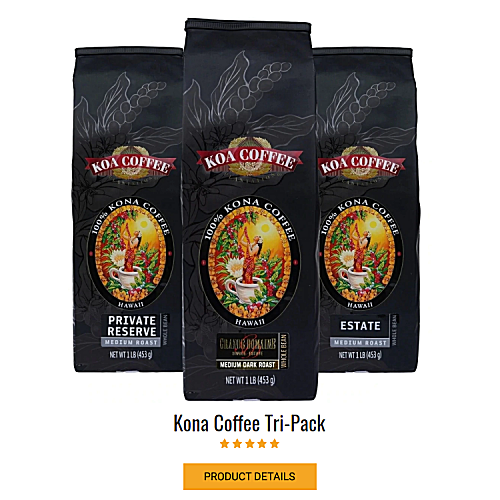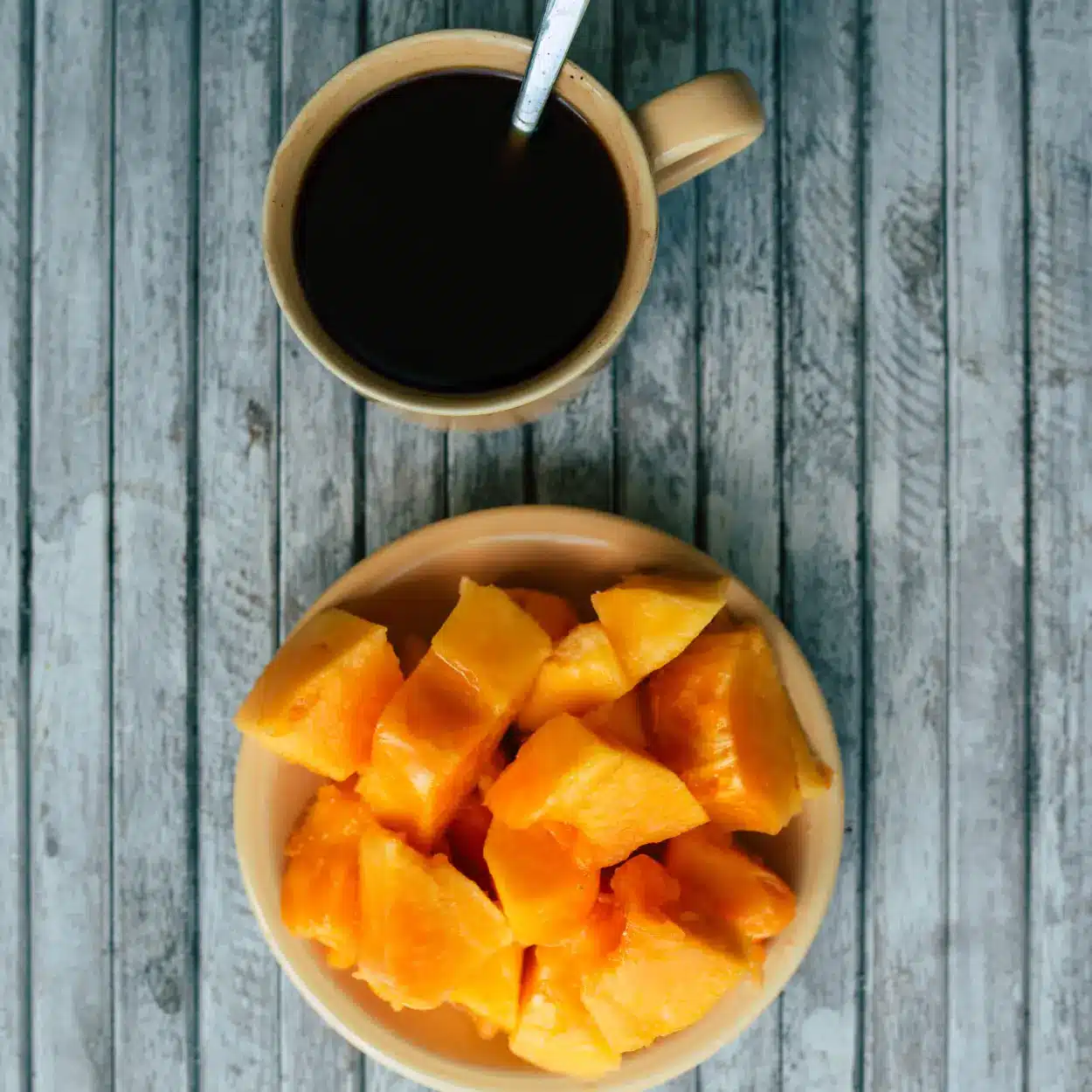Vietnam, a country renowned for its vibrant culture and stunning landscapes, also holds a cherished secret – its rich coffee heritage. Diving into the world of the best Vietnamese coffee beans is akin to embarking on a journey through time, where ancient traditions blend seamlessly with innovative techniques to produce coffee that delights the palate and soul. Whether you’re a seasoned coffee enthusiast or someone exploring global coffee flavors, this article offers a glimpse into the heart of Vietnam’s coffee legacy, ensuring every sip you take is infused with knowledge and appreciation. Join us as we unravel the captivating tale of Vietnamese coffee.
Vietnamese Coffee Beans: Key Takeaway
- Diverse Origins: Vietnam’s coffee regions, especially the Central Highlands, offer a distinctive palette of flavors and aromas, making the country a powerhouse in the global coffee scene.
- Sustainable Practices: With initiatives from the Institute of Policy and Strategy for Agriculture, as well as the Ministry of Agriculture and Rural Development, Vietnam is deeply invested in sustainable coffee farming, ensuring quality produce and environmental care go hand in hand.
- Fair Trade Commitment: Vietnam’s engagement with fair trade coffee certifications underscores its dedication to ethical production and trading, benefitting both the farmers and consumers.
- Heritage Brands: Homegrown brands, like Trung Nguyen, reflect Vietnam’s commitment to quality, tradition, and innovation, bridging the country’s rich coffee history with the present-day consumer experience.
- More than a Beverage: Vietnamese coffee, with its deep-rooted traditions and modern evolutions, represents a blend of culture, history, and passion, making every cup a reflection of Vietnam’s enduring coffee heritage.
Best Vietnamese Coffee Beans – A Look into the Top Brands
With Vietnam’s prominent status as a coffee-producing nation, the quest to identify the best Vietnamese coffee beans has become more exciting. The rich soil and favorable climates have given birth to numerous distinctive and delectable coffee varieties, each boasting its own flavor profile and brewing recommendations. Here’s an exploration of some notable selections that have caught the attention of coffee connoisseurs globally.
Cooper Cow Coffee – Classic Black, Churro and Vanilla Ground Vietnamese Coffee
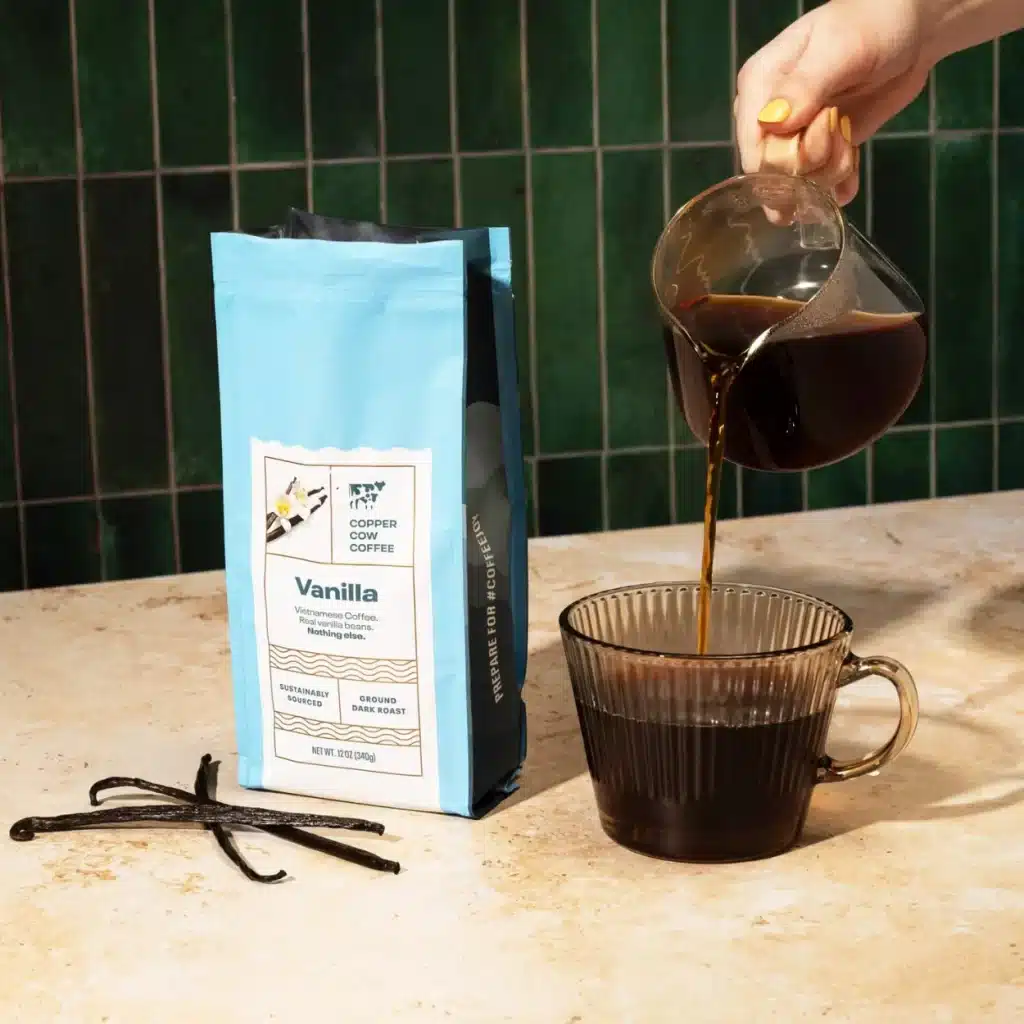
In the heart of Vietnam lies Cooper Cow Coffee, a brand that has masterfully blended robusta and arabica beans to deliver a tantalizing dance of rich chocolate notes intertwined with subtle hints of nuttiness. What sets this blend apart is the infusion of authentic cardamom, vanilla, and clove pods that impart genuine flavor without the intrusion of artificial additives.
Coffee Highlights:
- Eco-Conscious and Ethical: Pays Vietnamese farmers double the market rate while aiming to reduce their environmental footprint.
- Brew Flexibility: Versatile grind perfect for various brewing methods, from cold brew to French press.
- Natural Infusions: Authentic cardamom, vanilla, and clove pods are finely ground into the coffee.
PROS:
- Offers a velvety aftertaste.
- Ethically sourced, supporting local farmers.
- Infused with genuine flavors rather than artificial enhancements.
CONS:
- May not be suitable for those who prefer plain coffee without additional flavors.
Trung Nguyen Vietnamese Coffee
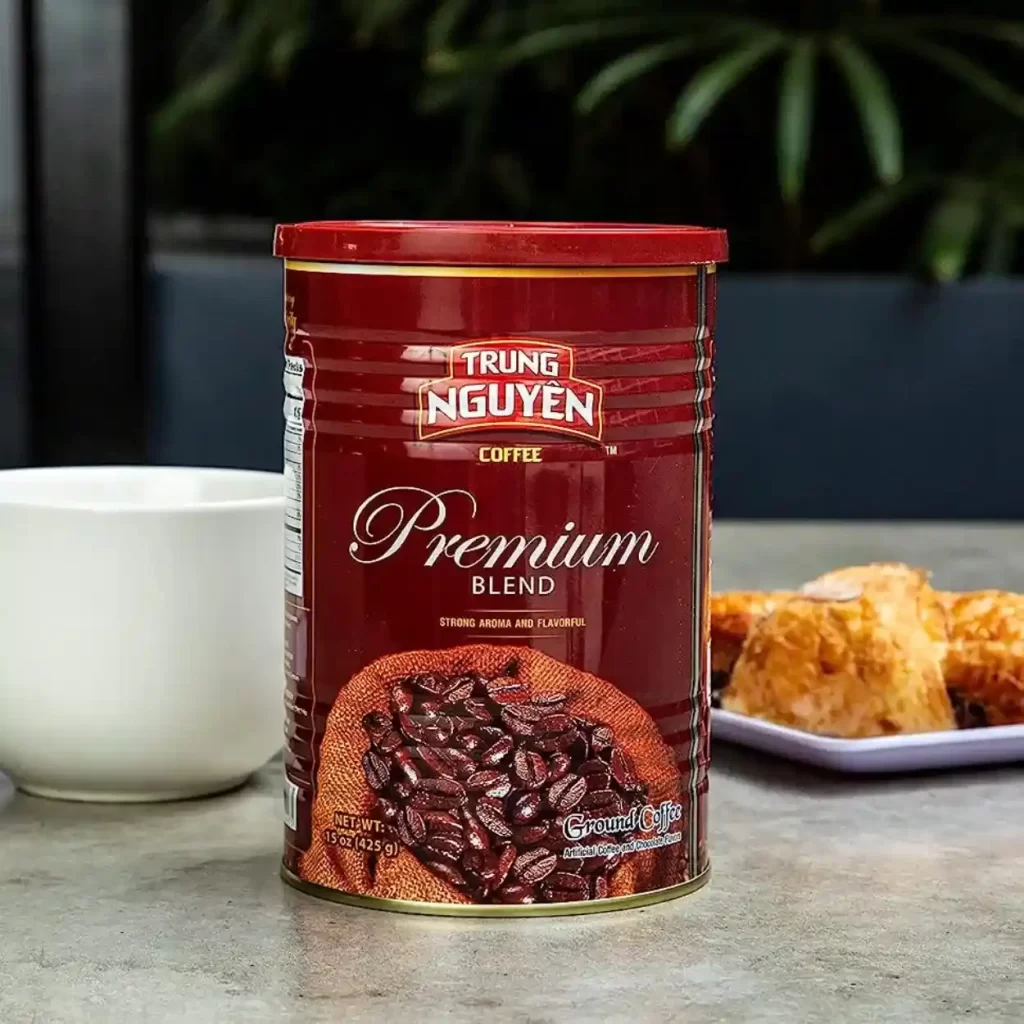
Trung Nguyen, a household name in Vietnam, has firmly established its presence in the global coffee arena. Since its inception in the late 1990s, Trung Nguyen has been synonymous with the rich and diverse coffee culture of Vietnam. The brand’s philosophy intertwines traditional brewing techniques with innovative blends, creating a captivating harmony of flavors. Trung Nguyen’s offerings are not just limited to Robusta; they also embrace Arabica, Excelsa, and Catimor, catering to a wide range of palates. Moreover, with its eco-conscious approach to sourcing and commitment to uplifting local farmers, the brand has been instrumental in shaping the contemporary coffee narrative of Vietnam.
Highlights:
- Diverse Coffee Offerings: From the bold Robusta to the aromatic Arabica, Trung Nguyen offers a coffee blend for every palate.
- Sustainable Practices: Their commitment to eco-friendly sourcing ensures that every cup of Trung Nguyen coffee has a reduced environmental footprint.
- Local Empowerment: By offering competitive prices to local farmers, Trung Nguyen contributes significantly to the socio-economic upliftment of Vietnam’s coffee-growing regions.
- Global Presence: With cafes and distribution in numerous countries, Trung Nguyen has successfully carried the essence of Vietnamese coffee culture across borders.
PROS:
- The brand maintains high-quality standards, ensuring that each coffee blend provides a consistent taste and aroma.
- With its roots deeply embedded in Vietnamese traditions, Trung Nguyen provides an authentic coffee experience.
- Apart from traditional beans, the brand has pioneered unique blends like the “Creative Coffee” series, offering consumers an avant-garde coffee experience.
CONS:
- Some consumers might find Trung Nguyen’s premium blends to be on the pricier side compared to other local brands.
- While it has a significant global presence, Trung Nguyen coffee might not be readily available in certain regions or require importing, leading to potential additional costs.
Trung Nguyen is more than just a coffee brand; it’s a testament to Vietnam’s rich coffee heritage and its aspirations for the future. Whether you’re savoring a cup in bustling Ho Chi Minh City or a distant part of the world, Trung Nguyen promises a rendezvous with the soul of Vietnamese coffee.
Nguyen Coffee Supply – Moxy Arabica: Medium Roast Vietnamese Coffee Beans
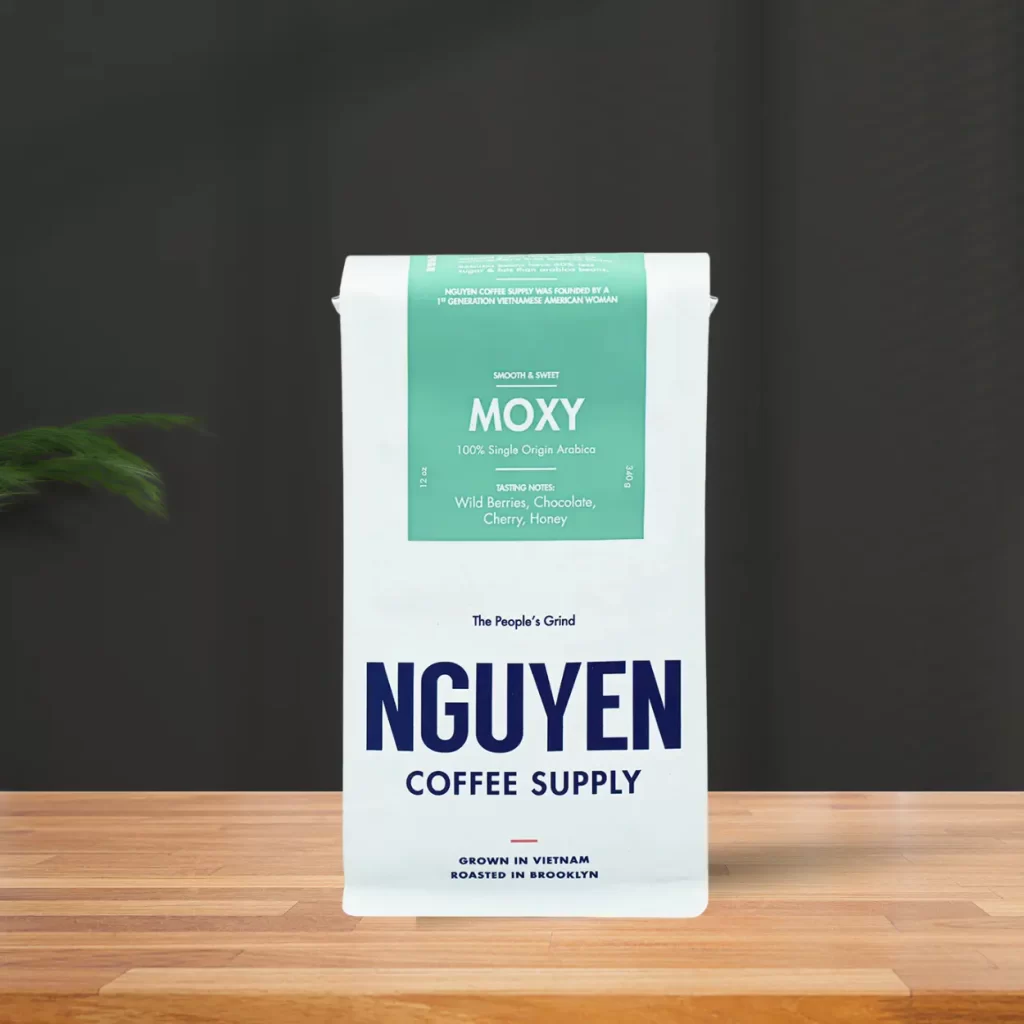
From the acclaimed Nguyen Coffee Supply, the Moxy Arabica blend stands as a testament to the exquisite flavors Vietnam has to offer. Crafted from rare specialty beans and roasted to perfection in Brooklyn, this blend promises a smooth, fruity profile without the commonly found acidic bitterness of many coffees.
Coffee Highlights:
- Origin and Roast: Expertly roasted in Brooklyn from premium Vietnamese beans.
- Exclusivity: Made entirely of Arabica beans, which constitute a minor fraction of Vietnam’s coffee produce.
- Collaborative Efforts: Direct collaboration with Mr. Ton, a 4th generation farmer from Vietnam’s Central Highlands.
PROS:
- Smooth and devoid of high acidic sourness.
- Versatile, given its whole bean form.
- Ethically sourced, supporting direct trade with Vietnamese farmers.
CONS:
- Quite pricey compared to other options
Chestbrew Whole Bean Vietnamese Coffee
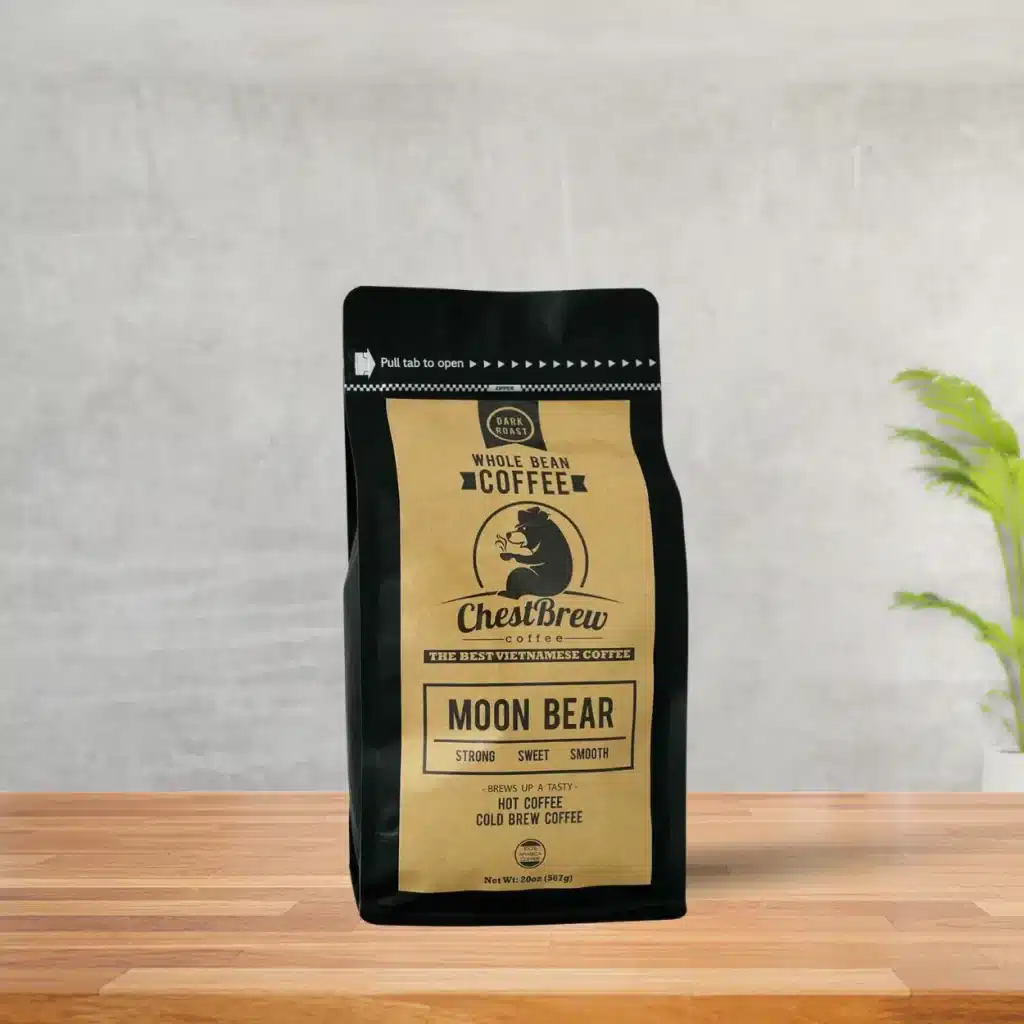
- Wake up your inner Big Bad Bear and go hard all day with your new favorite extra strong coffee.
Fuel your ambitions with ChestBrew Coffee, a blend that promises to reign supreme among coffee selections. Sourced exclusively from Vietnam’s finest coffee farms, these beans undergo meticulous roasting processes to yield a potent, silky, and exotic coffee experience.
Coffee Highlights:
- Single-Origin Excellence: Premium Arabica beans exclusively from Vietnam.
- Energizing Qualities: Formulated to fuel determination and drive.
- USFDA-Approved Roasting: High-quality roasting in an advanced facility.
PROS:
- Ideal for various brews, especially cold brew, and Vietnamese iced coffee.
- Ensures freshness with robust packaging.
- No additives during the roasting process.
CONS:
- Might be too potent for those who prefer milder blends.
Nguyen Coffee Supply – Truegrit Peaberry Robusta: Medium Roast Vietnamese Coffee Beans
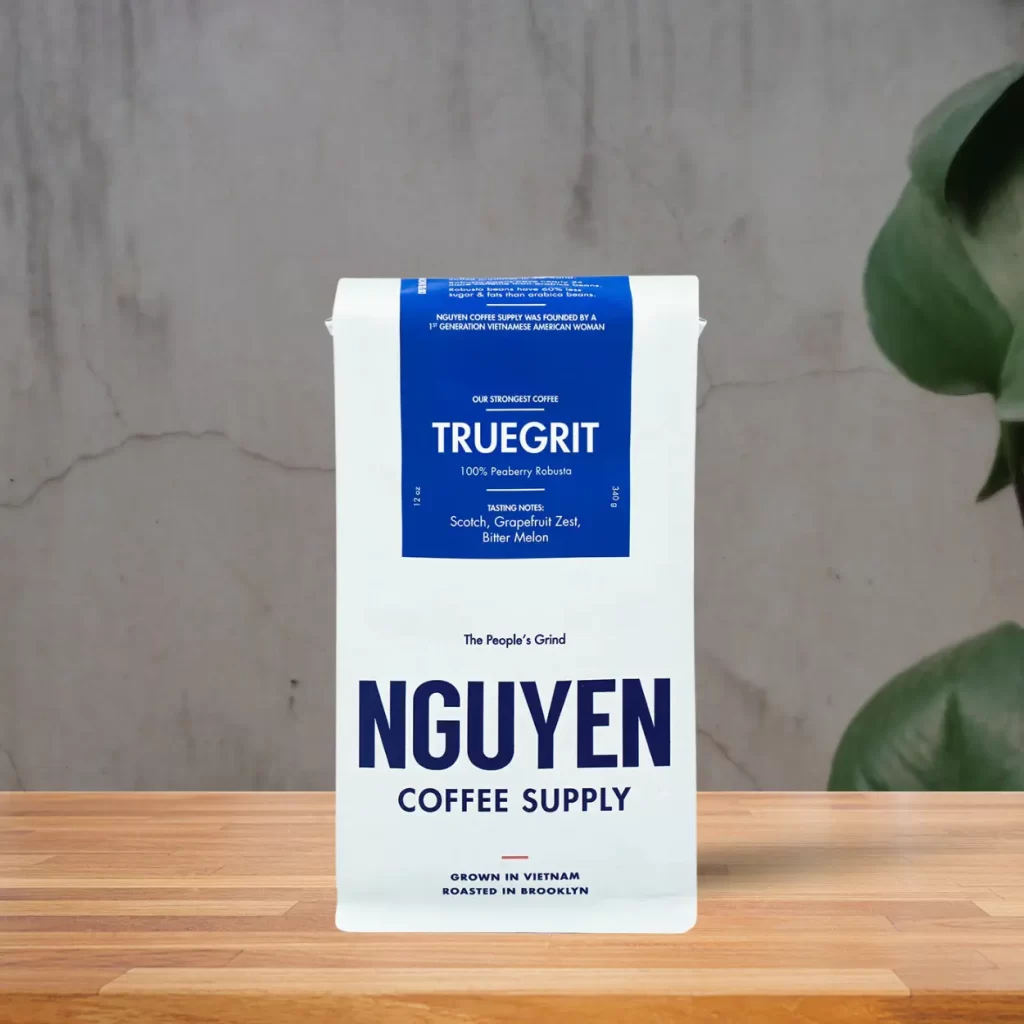
Experience the strength of Vietnam with the Truegrit Peaberry Robusta from Nguyen Coffee Supply. A blend that boasts nearly double the caffeine content of standard beans, this selection will entice you with its rich, full-bodied flavor and intriguing undertones of scotch, grapefruit zest, and bitter melon.
Coffee Highlights:
- Highly Potent: Offers an impressive caffeine kick for those long days.
- Robusta Excellence: Highlights the benefits of Robusta coffee beans, like reduced sugar and fat content.
- Direct Collaboration: Maintains a strong relationship with Mr. Ton, ensuring quality beans from the Central Highlands.
PROS:
- Provides a robust and impactful cup due to its Robusta composition.
- Roasted without additives or flavor enhancements.
- Supports direct trade, promoting ethical sourcing.
CONS:
- The high caffeine content may not be suitable for all coffee drinkers.
- Pricier than other options
Exploring the nuances of these blends uncovers the story of Vietnam’s coffee heritage. It’s not just about finding the best Vietnamese coffee beans; it’s about savoring a piece of Vietnam’s rich culture with each sip.
Vietnamese Coffee Bean Regions
Vietnam’s rise as one of the world’s largest coffee producers has spotlighted its regions teeming with unique coffee varieties. Each region, with its distinct climatic conditions and soil quality, contributes to the diverse flavor profiles of Vietnamese coffee beans. Two of the most renowned regions for their coffee production are the Central Highlands and Buôn Ma Thuột. Let’s delve into the specialty of these regions and explore what makes them stand out in the vast coffee landscape.
The Specialty of the Central Highlands
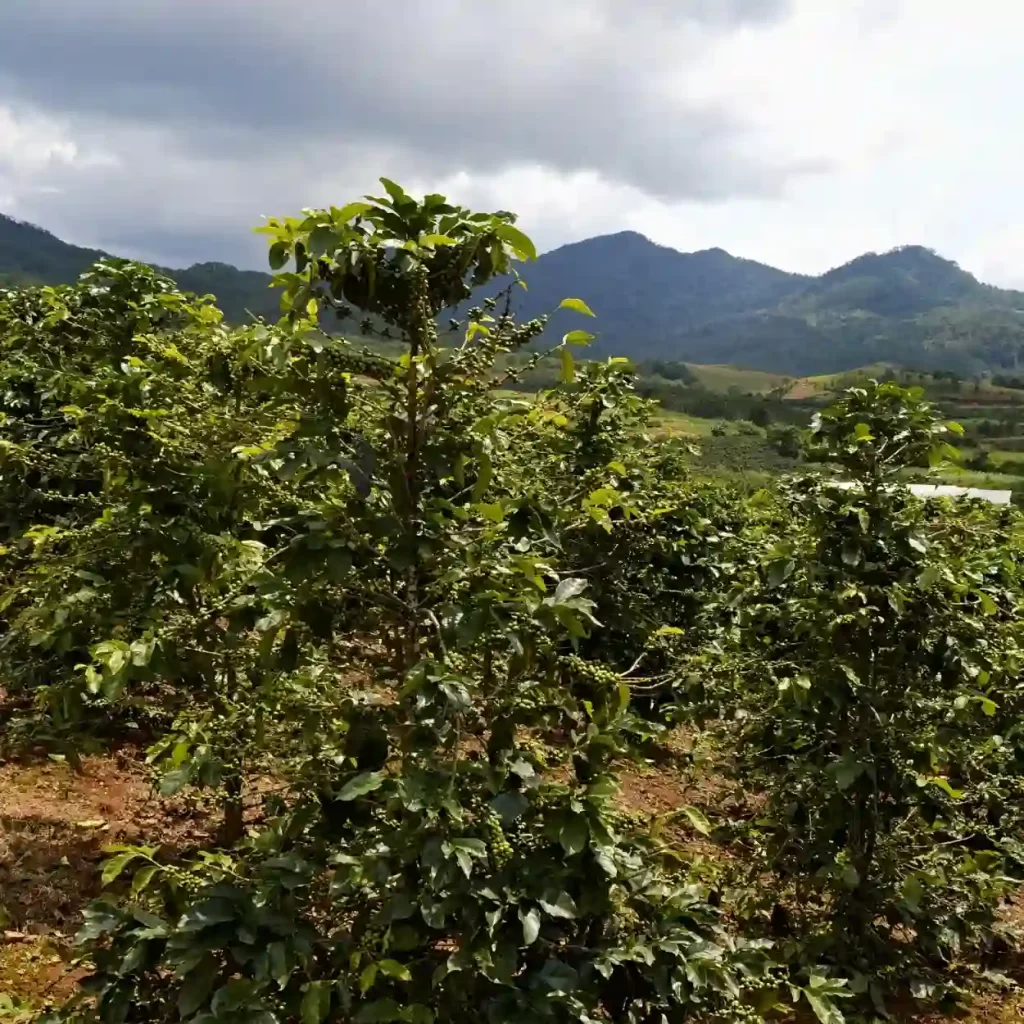
The Central Highlands, often referred to as the “heart of Vietnamese coffee production,” stretches across the southern part of central Vietnam. This elevated region boasts a harmonious blend of cool climate, plentiful rainfall, and fertile basaltic soil. Such favorable conditions make it an ideal setting for cultivating rich and flavorful coffee beans.
- Climatic Advantage: The consistent temperatures and timely monsoons in the Central Highlands ensure that coffee cherries mature uniformly, resulting in beans that produce a balanced brew.
- Robusta Dominance: While Vietnam grows a variety of coffee beans, the Central Highlands is particularly known for its Robusta beans. These beans are more resilient to pests and diseases and yield a strong brew, with a characteristic earthy flavor.
- Traditional Farming Techniques: Many farms in the Central Highlands still practice age-old farming techniques. The emphasis on natural and organic farming contributes to the beans’ pure and untainted flavor profile.
Buôn Ma Thuột: The Coffee Capital

Situated in the Đắk Lắk Province of the Central Highlands, Buôn Ma Thuột holds the esteemed title of the “Coffee Capital” of Vietnam. This city’s association with coffee dates back several decades, making it a pivotal hub for coffee trading and cultivation.
- Historical Significance: Buôn Ma Thuột has a rich history intertwined with coffee cultivation. Over the years, it has witnessed the evolution of coffee farming practices, processing methods, and trade dynamics. (1)
- Bean Diversity: Apart from the dominant Robusta beans, Buôn Ma Thuột is also a source of premium Arabica and the rare Excelsa beans. Each bean type, with its unique taste and aroma, adds to the city’s rich coffee tapestry.
- Coffee Tourism: Recognizing its position in the coffee world, Buôn Ma Thuột has developed coffee-related tourism. Tourists can visit sprawling coffee plantations, processing units, and even attend the annual Coffee Festival, celebrating the city’s deep-rooted bond with Vietnamese coffee beans. (2)
Understanding the significance of these regions provides insight into the journey of Vietnamese coffee beans, from the verdant plantations of the Central Highlands to the bustling streets of Buôn Ma Thuột, where the aroma of freshly brewed coffee lingers in the air, symbolizing Vietnam’s enduring coffee legacy.
A Brief History of Vietnamese Coffee
Vietnamese coffee, a symphony of bold flavors and rich history, has carved its niche on the global stage. Its journey, starting from colonial introductions to its modern-day renaissance, mirrors Vietnam’s resilience and adaptability. This story chronicles the ebbs and flows of Vietnamese coffee, and how it grew from a colonial enterprise to a defining facet of the nation’s culture and economy.
Early Beginnings: The French Introduction
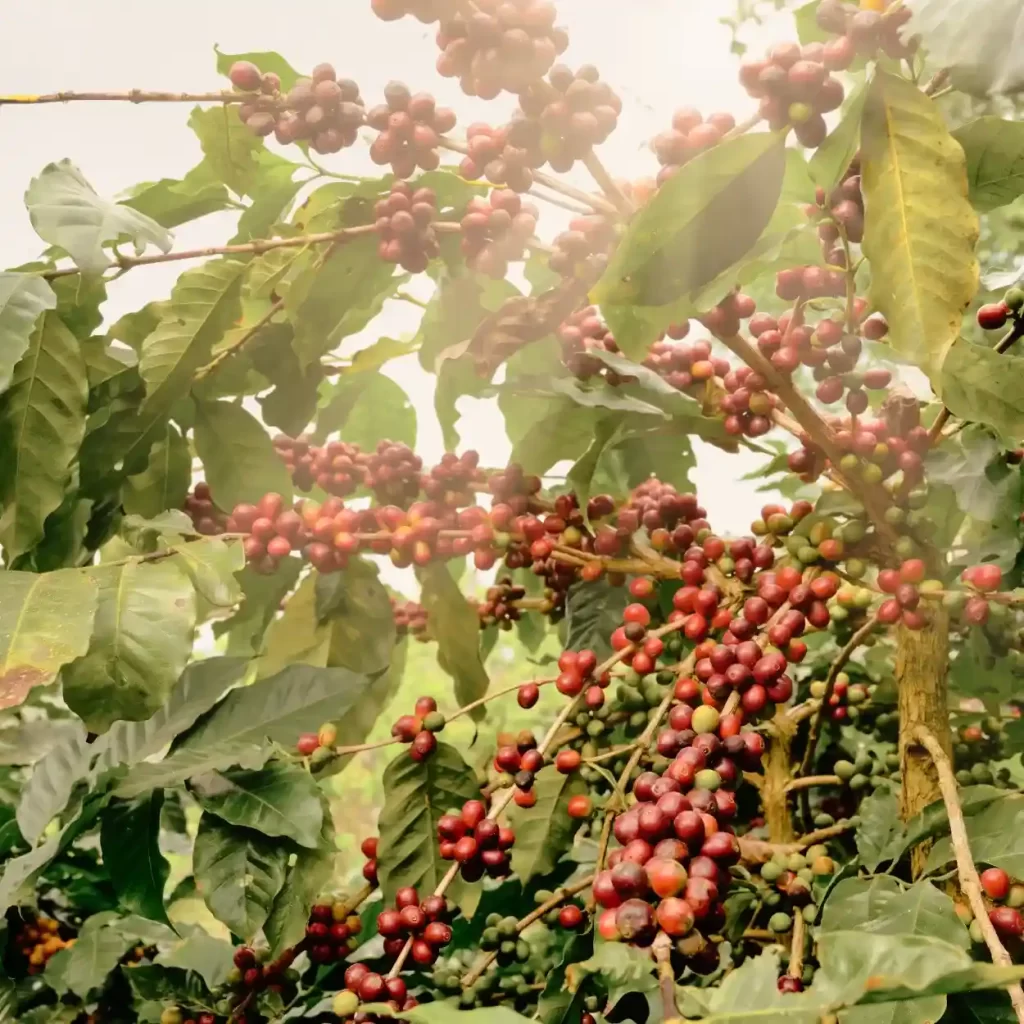
In the mid-19th century, the tapestry of Vietnamese agriculture was permanently altered by the introduction of coffee.
- The French Foray: French colonialists, always on the lookout for profitable ventures in their overseas territories, saw potential in the fertile Vietnamese lands. In 1857, French missionaries introduced coffee to Vietnam, marking the beginning of a transformative era.
- Setting Down Roots: The initial forays into coffee cultivation culminated in 1888 when vast swathes of land in the Ninh Bình and Quảng Bình provinces were converted into coffee plantations. This step solidified coffee’s position in Vietnam’s agricultural portfolio.
- Arabica’s Ascent: The initial choice was the Arabica variety, celebrated for its rich flavor and aroma. This coffee variant was not just an agricultural product but a reflection of the colonial taste that favored the refined notes of Arabica over other varieties.
The Rise of Robusta in Vietnam
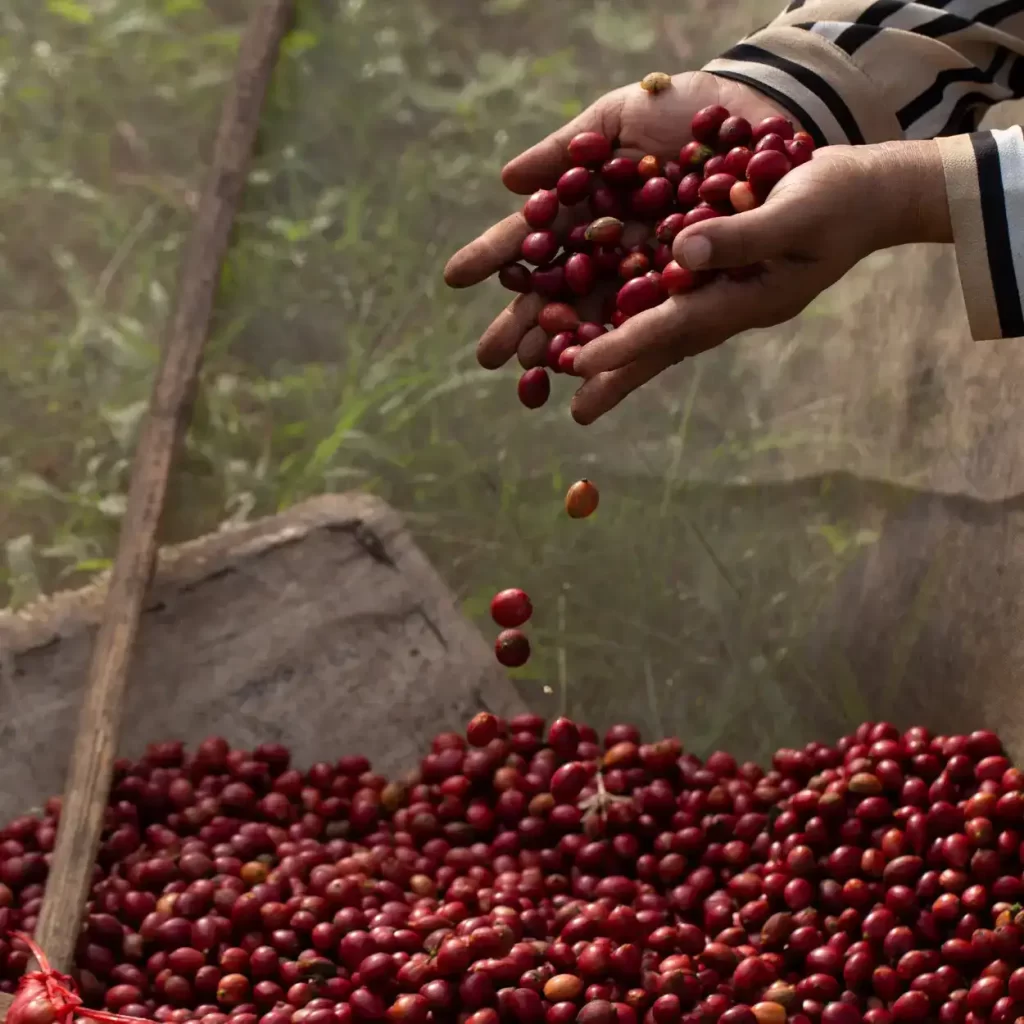
As the 20th century dawned, Vietnam’s coffee narrative underwent a significant shift with Robusta becoming the centerpiece.
- Decades of Development: The early decades of the 20th century were characterized by rapid expansion. The French, recognizing the potential of the Central Highlands, especially the Đắk Lắk Province, initiated large-scale coffee projects. By the time World War II loomed, Vietnam was exporting around 2,000 tons of coffee annually. (3)
- Why Robusta?: Robusta, known for its hardiness and higher yields, began to outpace Arabica in terms of cultivation. This trend was bolstered by the establishment of the Coronel Coffee Plant in 1969, dedicated to instant coffee production using primarily Robusta beans.
- Wartime Woes: The Vietnam War was a tumultuous phase. The key coffee region of Buôn Ma Thuột faced major disruptions due to its geographical importance. However, the aftermath firmly established Robusta, with it constituting a dominant 97% of Vietnam’s coffee output by the late 20th century.
The Modern Coffee Renaissance in Vietnam

Post-war Vietnam embarked on a journey of economic rejuvenation, and coffee was at its heart.
- Reforms and Resurgence: The Đổi mới reforms of 1986 were a turning point. Encouraging private ownership and fostering collaboration between stakeholders, these reforms reignited the growth of the coffee sector, positioning it as a key export.
- Labor Dynamics: The late 1970s saw significant demographic shifts. With labor shortages in the Central Highlands, many from the crowded lowlands migrated for opportunities, providing fresh impetus to the coffee industry.
- Towards Sustainability: The contemporary narrative of Vietnamese coffee is intertwined with sustainability. As the world’s second-largest coffee producer, Vietnam is at the forefront of sustainable farming initiatives. Environmental concerns like deforestation, declining soil fertility, and climate change are being actively addressed, ensuring that the legacy of Vietnamese coffee is preserved for future generations.
This journey, from French colonial interests to Vietnam’s stamp on the global coffee market, encapsulates the indomitable spirit of a nation and its coffee.
Bean Profiles: Robusta vs Arabica in Vietnam
Vietnam, with its rich coffee-growing legacy, has become synonymous with its distinctive beans. The narrative of Vietnamese coffee has primarily revolved around two protagonists: Robusta and Arabica. These beans, each with its own distinct personality, have contributed to the rich tapestry of the best Vietnamese coffee beans. Let’s delve deeper into their individual profiles and how they combine to create the perfect blend.
Understanding Robusta: Flavor, Texture, and Usage

Robusta beans, predominantly grown in the Central Highlands of Vietnam, have a unique profile that sets them apart in the world of coffee.
- Flavor Profile: Robusta is characterized by its bold, woody, and slightly astringent flavor. The high caffeine content (almost double that of Arabica) gives it a more bitter taste, often described as having notes of raw peanuts or dark chocolate.
- Texture and Crema: The coffee brewed from Robusta beans often has a heavier texture, providing a full-bodied mouthfeel. Furthermore, Robusta’s natural oil content contributes to a thicker, richer crema, enhancing the overall coffee experience.
- Usage in Vietnamese Coffee Culture: While Robusta might be perceived as inferior in Western coffee circles, it’s an integral part of Vietnamese coffee culture. The robust (pun intended) flavor of Robusta complements the sweetened condensed milk, making it a primary choice for traditional Vietnamese drip coffee.
Arabica’s Growth and Its Unique Vietnamese Touch

While Robusta may dominate the Vietnamese coffee bean market, Arabica has carved a niche of its own.
- Flavor Profile: Arabica beans are celebrated globally for their smooth, mellow flavor with hints of sugar, fruit, and berries. They have a wider taste range, from sweeter tones to tangier, more acidic notes.
- Vietnam’s Unique Touch: Vietnam has been successful in adding its own touch to Arabica cultivation. Beans grown in regions like Lam Dong and Son La are bathed in unique climatic conditions, resulting in Arabica beans with a delightful fusion of traditional flavor and a Vietnamese twist.
- Premium Segmentation: Given its rich and nuanced flavor profile, Arabica often caters to the premium segment of the market. It’s the bean of choice for those seeking a refined coffee experience, be it a simple espresso shot or a meticulously crafted pour-over.
The Perfect Balance: Blended Beans
Combining the strengths of both Robusta and Arabica, blended beans are becoming a popular choice.
- Why Blend?: Blending allows roasters to achieve a harmonious balance between the boldness of Robusta and the subtlety of Arabica. It results in a cup that offers both depth and nuance, providing an intricate palate experience.
- Popular Ratios: One common blend in Vietnam, and many other countries, is the 80-20 ratio, with 80% Robusta offering its intense flavor, complemented by 20% Arabica, adding the much-needed smoothness and aroma.
- Robusta vs Arabica: The debate on which is superior might never end, but what’s undeniable is that the blend of the two brings out the best of both worlds. The fusion ensures that connoisseurs and casual drinkers alike can find something they love in a cup of Vietnamese coffee.
The journey of understanding Vietnam’s coffee spectrum is as enriching as sipping a meticulously brewed cup. As the tale of Robusta vs Arabica unfolds, it’s clear that Vietnam, with its unparalleled coffee heritage, has mastered the art of cultivating, blending, and brewing beans to perfection.
Traditional Brewing Methods and Their Influence
Vietnam’s rich coffee culture, influenced by the unique microclimates of areas like Buôn Mê Thuột, has birthed brewing techniques and flavor profiles distinctively its own. These traditions have not only shaped the way Vietnamese coffee beans are cultivated and appreciated but have also influenced how they are brewed and served.
The Unique ‘Phin’ Brewing Technique

The traditional brewing method that distinctly characterizes Vietnamese coffee is the use of the ‘phin.’ This unique tool, much more than just a brewing device, embodies the essence of Vietnamese coffee culture.
- Method: Using the ‘phin’ involves placing the coffee grounds within its metal chamber, applying pressure with a perforated plate, and letting the hot water drip through. Unlike Western drip methods, the ‘phin’ brews coffee directly into the cup, with the process often presented right at the diner’s table.
- Exclusivity: The method harnesses the varied coffee species thriving in Buôn Mê Thuột’s microclimates. From the Catimor Arabica strains to indigenous varieties like Arabica SE, the ‘phin’ ensures that the complex flavors of these beans are fully extracted.
Drip Coffee Vs. The Phin: A Comparative Insight
While the drip coffee method is familiar in many Western cultures, the Vietnamese ‘phin’ offers a uniquely immersive experience.
- Drip Coffee: Often using machines or pour-over setups, the drip method is efficient and consistent. It usually focuses on extracting the bright notes of the coffee, allowing for a lighter flavor profile.
- The ‘Phin’: A more hands-on and personal technique, the ‘phin’ allows for a deeper extraction. This results in a full-bodied coffee that truly showcases the multifaceted flavors of Vietnamese coffee beans.
- The Experience: Beyond just flavor, using the ‘phin’ is ceremonial. The anticipation as each drop forms and the slow, meditative brewing process offer a coffee experience that’s as much about the journey as it is about the final cup.
The Role of Condensed Milk: Beyond Just a Sweetener

Condensed milk in Vietnamese coffee isn’t merely an additive; it’s a historical and cultural choice that has influenced the nation’s coffee palate.
- Historical Influence: The preference for sweetened condensed milk in Vietnam was born out of necessity. Given the tropical climate, fresh milk wasn’t always readily available, and even when it was, it was difficult to store. Condensed milk offered a shelf-stable alternative.
- Dual Purpose: Beyond its practicality, condensed milk imparts a creamy sweetness that perfectly counterbalances the robust flavor of the coffee. Over time, this combination has become not just preferred but cherished within the Vietnamese community.
- Popular Variations: With condensed milk as the base, variations like “cà phê sữa đá,” an iced coffee blend, have emerged. This refreshing concoction is a testament to the adaptability and innovation of Vietnamese coffee culture.
Delving into the traditions and intricacies of Vietnamese coffee reveals more than just brewing techniques; it uncovers stories, histories, and a deep-seated appreciation for the bean and the brew.
How to Serve Traditional Vietnamese Coffee
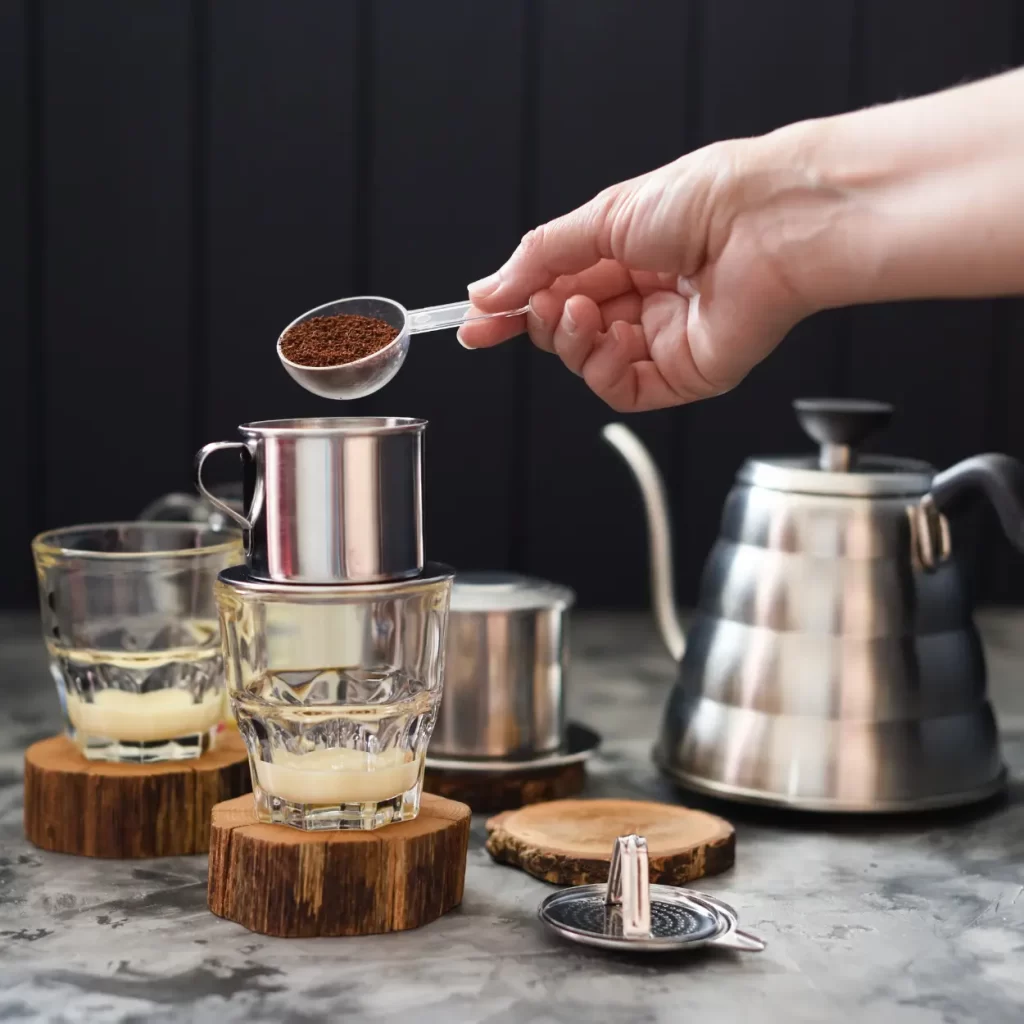
Traditional Vietnamese coffee is known for its rich flavor, characterized by a unique preparation method involving drip filtration and sweetened condensed milk. Its distinctiveness stems not just from the beans themselves, but from the way it’s brewed and presented. If you’re keen to savor this Southeast Asian delight at home, here’s a step-by-step guide to help you serve Vietnamese coffee in its most authentic form.
Ingredients:
- Freshly ground Vietnamese coffee beans
- Boiling water
- Sweetened condensed milk
Equipment Needed:
- Vietnamese drip filter (Phin)
- Glass or mug
Steps to Serve Traditional Vietnamese Coffee:
- Prepare the Glass: Begin by adding approximately 2-3 tablespoons of sweetened condensed milk to the bottom of your glass or mug. The quantity can be adjusted based on your sweetness preference.
- Add Coffee to the Filter: Take the Vietnamese drip filter (Phin) and remove the top screen. Place 2-3 tablespoons of freshly ground coffee beans into the filter.
- Compress the Grounds: Place the top screen over the coffee grounds and press it down gently. This ensures an even brew.
- Brewing: Pour a small amount of boiling water into the filter just to wet the coffee grounds. Wait for about 20 seconds. This allows the coffee to bloom, enhancing its flavor. Then, fill the filter with more boiling water.
- Drip and Wait: Position the filter on top of the glass or mug containing the condensed milk. Allow the coffee to drip slowly. This process may take several minutes. Be patient, as the slow drip brewing contributes to the coffee’s strong flavor.
- Stir and Enjoy: Once the dripping has stopped, stir the coffee and condensed milk together until well combined. Your traditional Vietnamese coffee is now ready to be savored. For an iced version, simply pour the mixture over a glass of ice cubes.
Tips for the Best Experience:
- Bean Choice: Opt for robusta beans for an authentic taste, as they are predominantly grown in Vietnam.
- Adjust to Taste: The sweetness level and coffee strength can be adjusted based on individual preferences.
- Water Temperature: Ensure the water is just off the boil (around 195°F or 90°C) for the best extraction.
By following these steps, you’ll be able to indulge in the rich and creamy world of traditional Vietnamese coffee, a treat that perfectly blends the boldness of coffee with the sweetness of condensed milk. Whether enjoyed as a morning pick-me-up or an afternoon delight, this beverage offers a taste of Vietnam’s cherished coffee culture.
Sustaining Traditions: Fair Trade and Organic Growth

Vietnam’s journey to sustainable coffee cultivation and the endorsement of fair trade coffee beans is rooted in strategic advancements and forward-thinking. With the rise of ethical consumerism globally, Vietnam has harnessed opportunities to transition its traditional coffee cultivation practices towards more sustainable and fair-trade initiatives.
The Evolution of Sustainable Farming in Vietnam
In recent years, Vietnam has shown a steadfast commitment to bolstering its coffee sector with a keen focus on sustainable and competitive practices. The country envisions a modern, diversified, and high-quality coffee industry that not only contributes to the global market but also elevates the standard of living for its farmers.
Objective and Vision
- By 2020, Vietnam aimed for a stable coffee plantation spanning approximately 600,000 hectares, with 80% dedicated to sustainable coffee production methods.
- The goal was to achieve a yield of 2.7 tons/ha, amassing a total production of 1.6 million tons annually.
- A boost in wet coffee processing from 10% to 30% was targeted, alongside enhancing the production of instant and ground coffee.
- The annual export value was projected to touch a range of 3.8 to 4.2 billion USD.
Key Regions for Coffee Production
- Four Central Highlands provinces, namely Dak Lak, Lam Dong, Gia Lai, and Dak Nong, were identified as pivotal regions, contributing the most significant share of the plantation area.
- Additional provinces like Dong Nai, Binh Phuoc, and Ba Ria-Vung Tau, among others, were also earmarked for coffee cultivation.
Revitalization of Plantation Areas
- A strategic approach was laid out for replanting coffee, with an annual target to rejuvenate 15-20% of the plantation area.
- By 2020, the aim was to introduce 100% new coffee varieties that are high-yielding, of superior quality, and can adapt to changing climatic conditions.
Sustainable Coffee Production Techniques
- Emphasis was placed on adopting sustainable coffee production techniques. By 2020, it was envisioned that around 80% of the coffee production process would integrate esteemed agricultural certifications like UTZ Certify, Rainforest Alliance, and VietGAP.
- Significant investments were funneled into developing geographical indications for premium coffee production.
Trade, Processing, and Management
- A strategic roadmap was outlined for upgrading coffee processing technologies, ensuring that by 2020, all coffee processing setups adhered to national safety standards.
- The country aimed to bolster its coffee trade, targeting direct exports to consumers and international roasters, sidestepping intermediaries.
- Efforts were also made to strengthen the domestic coffee consumption market and set up two major coffee exchanges in the Central Highlands and Ho Chi Minh city.
Science, Technology, and Training
- Vietnam resolved to invest in scientific research to develop new coffee varieties tailored for better yield, quality, and resilience against diseases and climatic challenges.
- In tandem, there was a concerted push to mechanize certain aspects of coffee cultivation, including tending, harvesting, and primary processing.
- Human resource development was underscored, focusing on training the next generation of coffee producers and technicians to cater to the evolving needs of the industry.
International Collaboration and Management
- Strengthening ties with other nations and global organizations was a core aspect, aimed at knowledge exchange in areas such as breeding, pest control, and water-efficient practices.
- Internally, the plan included restructuring state-owned enterprises to enhance the domestic coffee industry’s competitiveness and exploring public-private partnership models for the sector.
By strategically integrating these practices and focusing on sustainable development, Vietnam is carving a niche for itself in the global coffee industry, emphasizing both quality and quantity while ensuring prosperity for its farmers. (4)
Benefits of Organic Vietnamese Coffee

Organic coffee farming eliminates synthetic chemicals, fostering healthier soil and ecosystems. Vietnam, having realized the potential health and environmental advantages, has made strides toward adopting these organic practices. Vietnam has embarked on a journey to produce coffee that’s both high-quality and eco-friendly. Organic Vietnamese coffee not only contributes to a cleaner environment but also ensures consumers get a richer, chemical-free taste in every cup.
Highlights:
- Enhanced Soil Health: Organic practices rejuvenate the soil, ensuring longevity and better crop yields.
- Richer Taste: The absence of synthetic chemicals allows the authentic flavor of the coffee bean to shine through.
- Eco-friendly: Contributes significantly to reducing harmful environmental footprints.
Supporting Fair Trade: A Win-Win for Farmers and Consumers
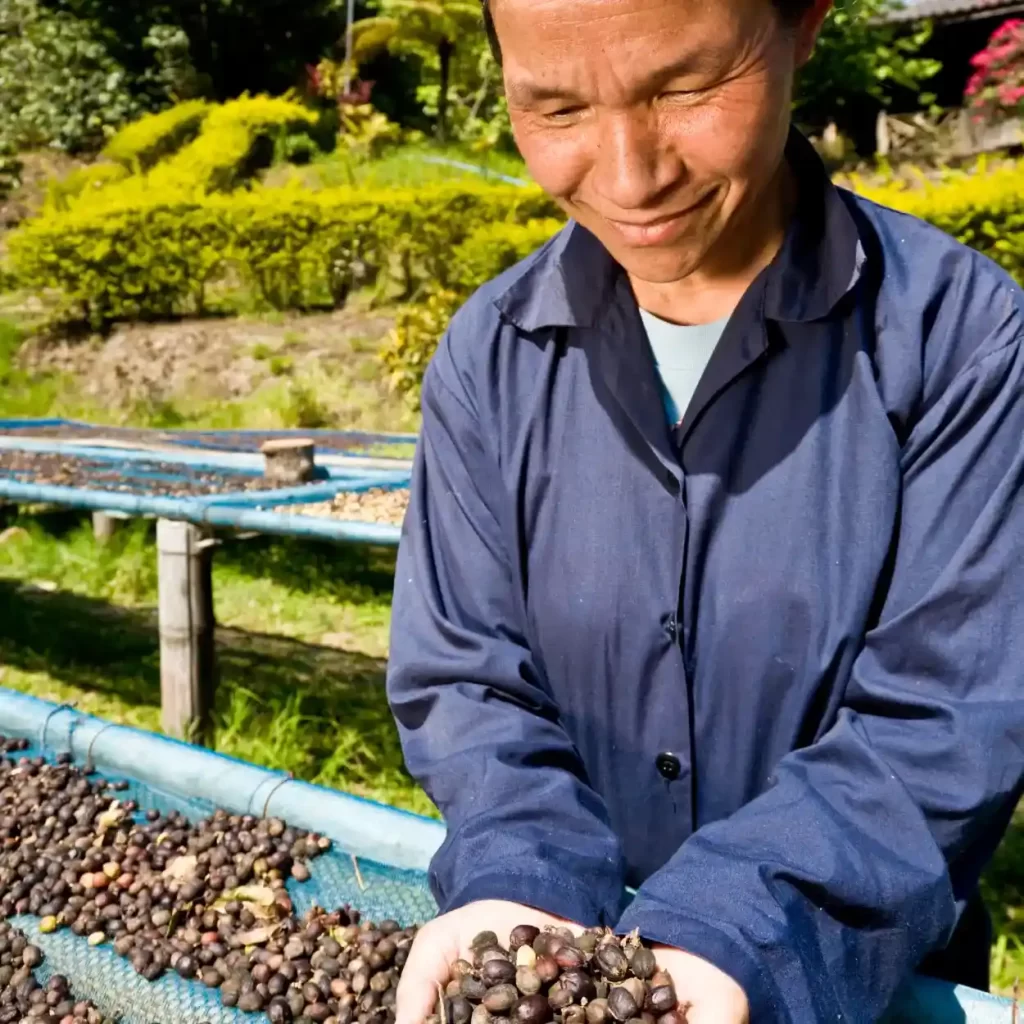
Fairtrade coffee certifications, such as the Rainforest Alliance and UTZ, are gaining traction in Vietnam. These certifications don’t just validate the quality of Vietnamese coffee; they also empower farmers by ensuring they receive a fair price for their produce. The Vietnamese government has recognized the dual potential of fair trade coffee beans: supporting local farmers and reinforcing Vietnam’s global coffee identity. Although there’s some skepticism around the fair-trade narrative—often seen as a construct for international consumers—the essence of these initiatives is undeniable. They foster transparency, uplift farming communities, and ensure that consumers can trust the source of their morning brew.
Highlights:
- Empowering Farmers: Fairtrade initiatives ensure that local coffee farmers are adequately compensated, elevating their living standards.
- Promoting Transparency: Audits associated with these certifications ensure accountability, helping consumers make informed choices.
- Reinforcing Global Identity: Brands like Trung Nguyên have effectively utilized their origin story, enhancing Vietnam’s image in the global coffee market.
| Preview | Product | |
|---|---|---|

|
Copper Cow Coffee Pour Over Vietnamese Ground Coffee Pouches + Sweetened Condensed Milk Creamers (8… | See on Amazon |

|
Saigon Phin Daklak (Vietnamese Coffee) | See on Amazon |
Conclusion
As our exploration of the best Vietnamese coffee beans comes to a close, it becomes evident that Vietnam’s coffee narrative is about much more than just a beverage. It’s a tale of tradition, innovation, and resilience, woven through generations and mirrored in every cup brewed. With its unique flavors, sustainable farming practices, and the relentless spirit of its growers, Vietnamese coffee stands as a testament to the country’s rich heritage and passion for excellence. Whether you’re savoring a cup brewed from beans of the Central Highlands or indulging in a concoction inspired by modern brands, remember: every sip you take is a celebration of Vietnam’s profound coffee legacy. Cheers to discovering, enjoying, and preserving this incredible heritage!
FAQ
How has the Vietnamese War influenced coffee production in Vietnam?
The Vietnamese War disrupted coffee production initially, but post-war policies and rehabilitation efforts significantly boosted the industry.
What's the difference in caffeine content between Robusta and Arabica?
Robusta beans generally contain about twice as much caffeine as Arabica beans.
Why is condensed milk so popular in Vietnamese coffee?
Condensed milk became popular in Vietnamese coffee due to a historical lack of fresh milk and its ability to balance the strong, robust flavors of local beans.
How do altitude and soil affect the flavor profile of Vietnamese coffee beans?
Altitude and soil contribute to the beans' acidity, body, and flavor nuances, with higher elevations often resulting in a more nuanced and complex flavor profile.
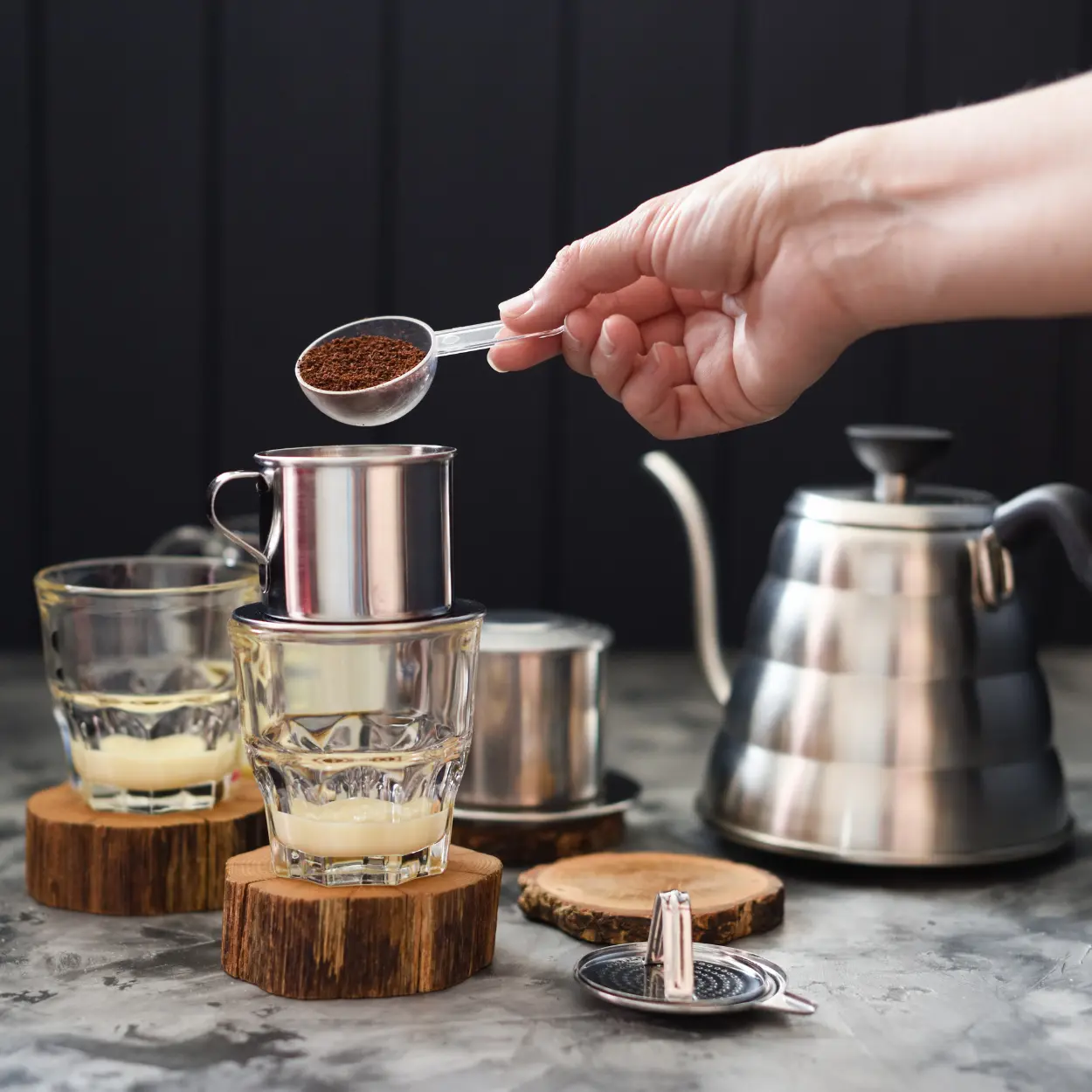


![Nguyen Coffee Supply - Moxy Arabica: Medium Roast Premium Whole Coffee Beans, Vietnamese Single Origin, Direct Trade, Roasted in Brooklyn [12 oz Bag]](https://m.media-amazon.com/images/I/41UwCwO9vrL._SL160_.jpg)
![Nguyen Coffee Supply - Moxy Arabica: Medium Roast Premium Ground Coffee Beans, Vietnamese Single Origin, Direct Trade, Roasted in Brooklyn [12 oz Bag]](https://m.media-amazon.com/images/I/41juqyTx6UL._SL160_.jpg)

![Nguyen Coffee Supply - Truegrit Robusta: Medium Roast Premium Whole Coffee Beans, Vietnamese Single Origin, Direct Trade, Low Acid with High Caffeine Content, Roasted in Brooklyn [12 oz Bag]](https://m.media-amazon.com/images/I/41bn3Dt3gnL._SL160_.jpg)
![Nguyen Coffee Supply - Truegrit Robusta: Medium Roast Ground Coffee Beans, Vietnamese Single Origin, Direct Trade, Low Acid with High Caffeine Content, Roasted in Brooklyn [12 oz Bag]](https://m.media-amazon.com/images/I/41MIkoCWfcL._SL160_.jpg)

